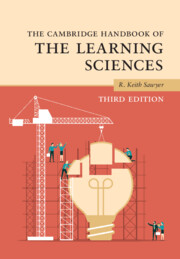Book contents
- The Cambridge Handbook of the Learning Sciences
- The Cambridge Handbook of the Learning Sciences
- Copyright page
- Contents
- Figures
- Tables
- Contributors
- Preface
- 1 An Introduction to the Learning Sciences
- Part I Foundations
- Part II Methodologies
- Part III Grounding Technology in the Learning Sciences
- 14 Video Games and Learning
- 15 Embodiment and Embodied Design
- 16 Tangible and Full-Body Interfaces in Learning
- 17 Augmented Reality in the Learning Sciences
- 18 Mobile Learning
- Part IV Learning Together
- Part V Learning Disciplinary Knowledge
- Part VI Moving Learning Sciences Research into the Classroom
- Index
- References
14 - Video Games and Learning
from Part III - Grounding Technology in the Learning Sciences
Published online by Cambridge University Press: 14 March 2022
- The Cambridge Handbook of the Learning Sciences
- The Cambridge Handbook of the Learning Sciences
- Copyright page
- Contents
- Figures
- Tables
- Contributors
- Preface
- 1 An Introduction to the Learning Sciences
- Part I Foundations
- Part II Methodologies
- Part III Grounding Technology in the Learning Sciences
- 14 Video Games and Learning
- 15 Embodiment and Embodied Design
- 16 Tangible and Full-Body Interfaces in Learning
- 17 Augmented Reality in the Learning Sciences
- 18 Mobile Learning
- Part IV Learning Together
- Part V Learning Disciplinary Knowledge
- Part VI Moving Learning Sciences Research into the Classroom
- Index
- References
Summary
This chapter reviews research on how video games have been used in schools and other learning environments and how they impact learning outcomes. This chapter reviews four functions of video games in learning. Games as content teach specific disciplinary knowledge, for example in history, math, second language learning, physics, and medicine. Games as bait leverage the engaging aspects of video games to attract students to the game even when it is not obviously about learning. Games as assessment use the “leveling up” feature of games, where players advance to the next level as their skills increase, as a way to assess the player’s developing knowledge. Games as architectures for engagement are studied by examining how and why people play games and how they can be designed to best foster learning by fostering involvement, immersion, and investment – often using narrative structures. There is evidence that when games are designed on learning sciences principles, they contribute to deeper learning.
- Type
- Chapter
- Information
- The Cambridge Handbook of the Learning Sciences , pp. 281 - 300Publisher: Cambridge University PressPrint publication year: 2022

